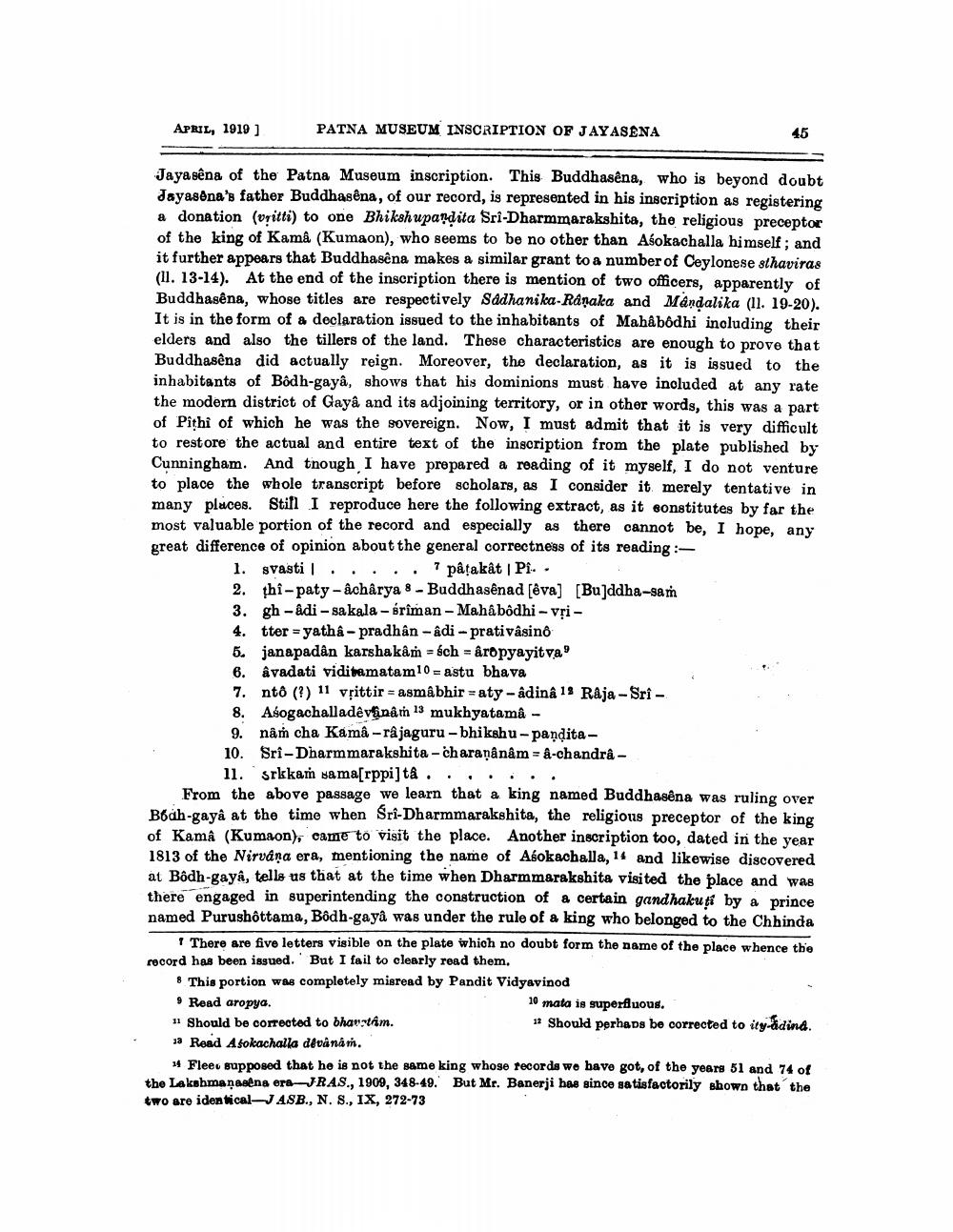________________
APRIL, 1910)
PATNA MUSEUM INSCRIPTION OF JAYASENA
Jaya sena of the Patna Museum inscription. This Buddhasêna, who is beyond doubt Jayasena's father Buddhasêna, of our record, is represented in his inscription as registering a donation (vritti) to one Bhikshupandita Sri-Dharmmarakshita, the religious preceptor of the king of Kama (Kumaon), who seems to be no other than Asokachalla himself; and it further appears that Buddhasêna makes a similar grant to a number of Ceylonese sthaviras (11. 13-14). At the end of the inscription there is mention of two officers, apparently of Buddhasêna, whose titles are respectively Sadhanika-Ránaka and Måndalika (11. 19-20). It is in the form of a declaration issued to the inhabitants of Mahâbodhi including their elders and also the tillers of the land. These characteristics are enough to prove that Buddhagêna did actually reign. Moreover, the declaration, as it is issued to the inhabitants of Bôdh-gayâ, shows that his dominions must have inoluded at any rate the modern district of Gaya and its adjoining territory, or in other words, this was a part of Pithi of which he was the sovereign. Now, I must admit that it is very difficult to restore the actual and entire text of the inscription from the plate published by Cunningham. And tnough I have prepared a reading of it myself, I do not venture to place the whole transcript before scholars, as I consider it merely tentative in many places. Still I reproduce here the following extract, as it sonstitutes by far the most valuable portion of the record and especially as there cannot be, I hope, any great difference of opinion about the general correctness of its reading :
1. svasti ..... 7 pâţakât Pi.. 2. thi-paty - acharya & Buddhasênad sêva] [Bulddha-garn 3. gh-adi - Sakala - srîman - Mahâbôdhi - yri4. tter =yatha - pradhân - adi-prativasino 5. janapadân karshakam = sch = âropyayitva' 6. Ävadati viditematam 10 - astu bhava 7. nto (?) 11 vșittir - asmâbhir = aty - adina 19 Râja - Sri - 8. Asogachalladê vainâmn 13 mukhyatama - 9. naṁ cha Kama-rå jaguru - bhikshu-pandita - 10. Sri-Dharmmarakshita - charaņân&m= &-chandra -
11. srkkam sama[rppi]tå...... From the above passage we learn that a king named Buddhasêna was ruling over B6dh-gaya at the time when Sri-Dharmmarakshita, the religious preceptor of the king of Kamâ (Kumaon), came to visit the place. Another inscription too, dated in the year 1813 of the Nirvana era, mentioning the name of Asokachalla, 14 and likewise discovered at Bødh-gaya, tells us that at the time when Dharmmarakshita visited the place and was there engaged in superintending the construction of a certain gandhakuti by a prince named Purushottama, Bôdh-gaya was under the rule of a king who belonged to the Chhinda
1 There are five letters visible on the plate which no doubt form the name of the place whence the rooord has been issued. But I fail to clearly read them.
* This portion was completely misread by Pandit Vidyavinod 9 Read aropya.
10 mata is superfluous. u Should be corrected to bhaustam.
11 Should perhaps be corrected to ity-ddind. ja Road Asokachalla devanań.
24 Fleeu supposed that he is not the same king whose records we have got, of the years 51 and 74 of the Lakshmanae na ere—JRAS., 1909, 348-49. But Mr. Banerji has since satisfactorily shown that the two are identical ASB., N. S., IX, 272-73




